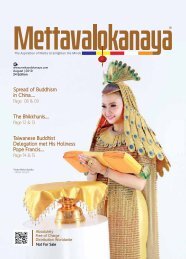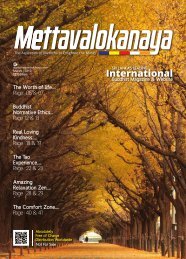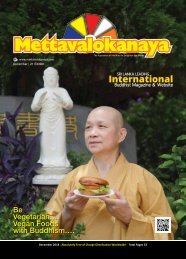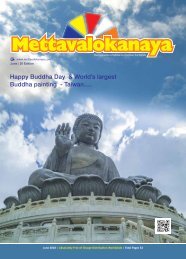mettavalokanaya_international_buddhist_magazine_september_2020
This is the Sri Lankan's Most Popular & Leading Monthly International Buddhist Magazine, “Mettavalokanaya” on September - 2020 Edition - 29. “Mettavalokanaya” International Buddhist Magazine has been successfully distributed to 40 countries worldwide. Specially distributed to Overseas High Buddhist Monks, Masters, Nuns, Worldwide famous Buddhist Monasteries & Associations, International Buddhist conferences and Forums. “Mettavalokanaya” International Monthly Buddhist Magazine has been awarded as the “2018 - The Global Buddhist Ambassador Award” from Thailand as the World’s Best and Most popular Buddhist Magazine. The Mettavalokana Buddhist Publications Centre is a registered Buddhist Publications Centre in Sri Lanka and has received many International accolades. Our publications are absolutely free of charge to general public. The magazine comprises of special articles on Buddhism written by leading Buddhist Monks from foreign countries. “Mettavalokanaya” is currently been published in English and includes full color 60 pages.
This is the Sri Lankan's Most Popular & Leading Monthly International Buddhist Magazine, “Mettavalokanaya” on September - 2020 Edition - 29. “Mettavalokanaya” International Buddhist Magazine has been successfully distributed to 40 countries worldwide. Specially distributed to Overseas High Buddhist Monks, Masters, Nuns, Worldwide famous Buddhist Monasteries & Associations, International Buddhist conferences and Forums. “Mettavalokanaya” International Monthly Buddhist Magazine has been awarded as the “2018 - The Global Buddhist Ambassador Award” from Thailand as the World’s Best and Most popular Buddhist Magazine. The Mettavalokana Buddhist Publications Centre is a registered Buddhist Publications Centre in Sri Lanka and has received many International accolades. Our publications are absolutely free of charge to general public. The magazine comprises of special articles on Buddhism written by leading Buddhist Monks from foreign countries. “Mettavalokanaya” is currently been published in English and includes full color 60 pages.
You also want an ePaper? Increase the reach of your titles
YUMPU automatically turns print PDFs into web optimized ePapers that Google loves.
The
Karma….
actions is habit and habit become one’s
character.
In Buddhism, this process is called
karma. In its ultimate sense, karma
means both good and bad, mental
action or volition. ‘Karma is volition,’
says the Buddha. Thus karma is not
an entity but a process, action, energy
and force. Some interpret this force as
‘action-influence’. It is our own doings
reacting on ourselves. The pain and
happiness a person experiences are the
results of his or her own deeds, words
and thoughts reacting on themselves.
Our deeds, words and thoughts produce
our prosperity and failure, our happiness
and misery. Karma is an impersonal,
natural law that operates strictly in
accordance with our actions. It is a law
and does not have any lawgiver. Karma
operates in its own field without the
intervention of an external, independent
ruling agency. Since there is no hidden
agent directing or administering
rewards and punishments, Buddhists do
not rely on prayer to some supernatural
forces to influence karmic results.
According to the Buddha, karma is
neither predestination nor determinism
imposed on us by some mysterious,
unknown powers or forces to which we
must helplessly submit ourselves.
(Tribute to Most Venerable Dr.
Kirinde Sri Dhammananda Maha Thero)
We notice how life changes
and how it continually
moves between extremes
and contrasts. We notice
rise and fall, success and failure, loss
and gain; we experience honor and
contempt, praise and blame; and we feel
how our hearts respond to happiness
and sorrow, delight and despair,
disappointment and satisfaction, fear
and hope. These mighty waves of
emotion carry us up, fling us down, and
no sooner do we find some rest, than we
are carried by the power of a new wave
again. How can we expect a footing on
the crest of the waves? Where shall we
erect the building of our life in the midst
of this ever-restless ocean of existence?
This is a world where any little
joy that is allotted to beings is secured
only after many disappointments,
failures and defeats. This is a world
where scanty joy grows amidst sickness,
desperation and death. This is a world
where beings who a short while ago
were connected with us by sympathetic
joy are at the next moment in want of
our compassion. Such a world as this
needs equanimity. It is the nature of
the world that we live with our intimate
friends who the next day can become
our enemies to harm us.
The Buddha described the world
as an unending flux of becoming. All is
changeable, continuous transformation,
ceaseless mutation, and a moving
stream. Everything exists from moment
to moment. Everything is a recurring
rotation of coming into being and then
passing out of existence. Everything
is moving from birth to death. Life is
a continuous movement of change
towards death. The matter or material
forms in which life does or does not
express itself, are also a continuous
movement or change towards decay.
This teaching of the impermanent
nature of everything is one of the main
pivots of Buddhism. Nothing on earth
partakes of the character of absolute
reality. That there will be no death of
what is born is impossible. Whatever
is subject to origination is subject also
to destruction. Change is the very
constituent of reality. The Buddha
reminded us that all existing component
things are impermanent. With birth,
there is death; with arising, there is
dissolving; with coming together, there
is separation. How can there be birth
without death? How can there be
arising without dissolving?
How can there be coming together
without separation? In declaring the
Law of Impermanence or change,
the Buddha denies the existence of
eternal substances. Matter and spirit
are false abstractions that, in reality,
are only changing factors (Dharma)
which are connected, and which arise in
functional dependence on each other.
Today, scientists have accepted the law
of change that was discovered by the
Buddha. Scientists postulate that there
is nothing substantial, solid and tangible
in the world. Everything is a vortex of
energy, never remaining the same for
two consecutive moments. The whole
wide world is caught up in this whirl and
vortex of change. One of the theories
postulated by scientists is the prospect
of the ultimate coldness following
upon the death or destruction of the
sun. Buddhists are not dismayed by
this prospect. The Buddha taught that
universes or world cycles arise and pass
away in endless succession, just as the
lives of individuals do. Our world will
most certainly come to an end before
other worlds come into existence. It has
happened before with previous worlds
and it will happen again. It is simply a
matter of time.
The world is a passing
phenomenon. We all belong to the
world of time. Every written word,
every carved stone, every painted
picture, the structure of civilization,
every generation of human beings, will
vanish away like the leaves and flowers
of forgotten summers. What exists is
changeable and what is not changeable
does not exist.’ Thus, all gods and
human beings and animals and material
forms— everything in this universe—is
subject to the law of impermanency.
Buddhism teaches us that the mind
seeks a permanent existence, but
life creates an impermanent physical
body. We take this as life, and then
satisfactoriness disturbs the mind. This
is the source of suffering.
Karma can be put in the simple
language of the child: do good and good
will come to you, now, and hereafter.
Do bad and bad will come to you, now,
or hereafter. In the language of the
harvest, karma can be explained in this
way: if you sow good seeds, you will
reap a good harvest. If you sow bad
seeds, you will reap a bad harvest. In
the language of science, karma is called
the law of cause and effect: every cause
has an effect. Another name for this
is the law of moral causation. Moral
causation works in the moral realm
just as the physical law of action and
reaction works in the physical realm.
In the DHAMMAPADA, karma is
explained in this manner: the mind is
the chief (forerunner) of all good and
bad states. If you speak or act with a
bad mind, then unhappiness follows
you just as the wheel follows the hoof
of the ox. If you speak or act with a
good mind, then happiness follows you
like the shadow that never leaves you.
Karma is simply action. Within animate
organisms there is a power or force
which is given different names such as
instinctive tendencies, consciousness,
etc. This innate propensity forces
every conscious being to move. A
person moves mentally or physically.
His motion is action. The repetition of
Malaysia
Most Venerable
Datuk Kirinde
Dhammaratana
Nayaka Maha
Thero
“Buddhism
Teach us
about the
Mind”….
12 l Mettavalokanaya l September l 2020 2020 l September l Mettavalokanaya l 13
















